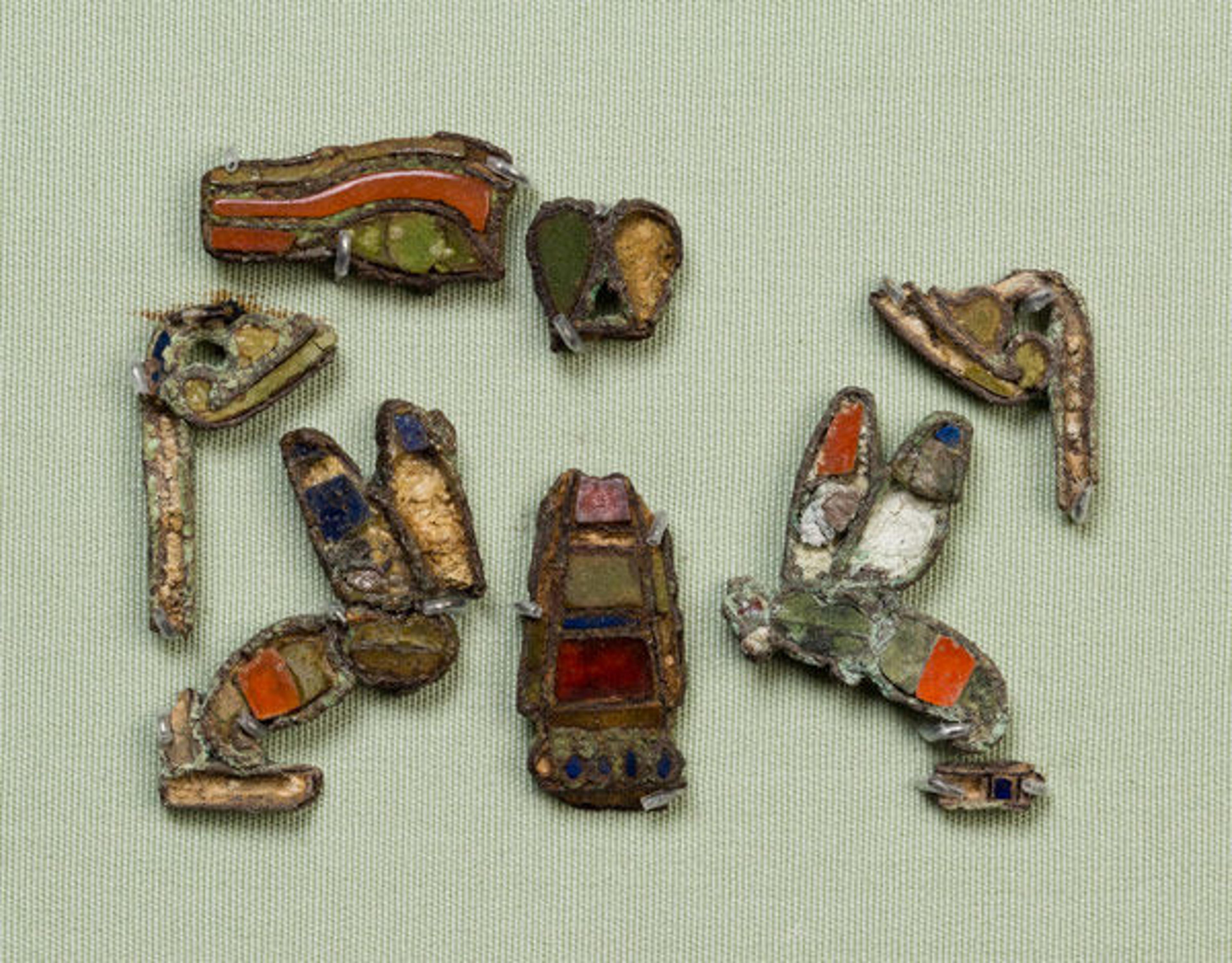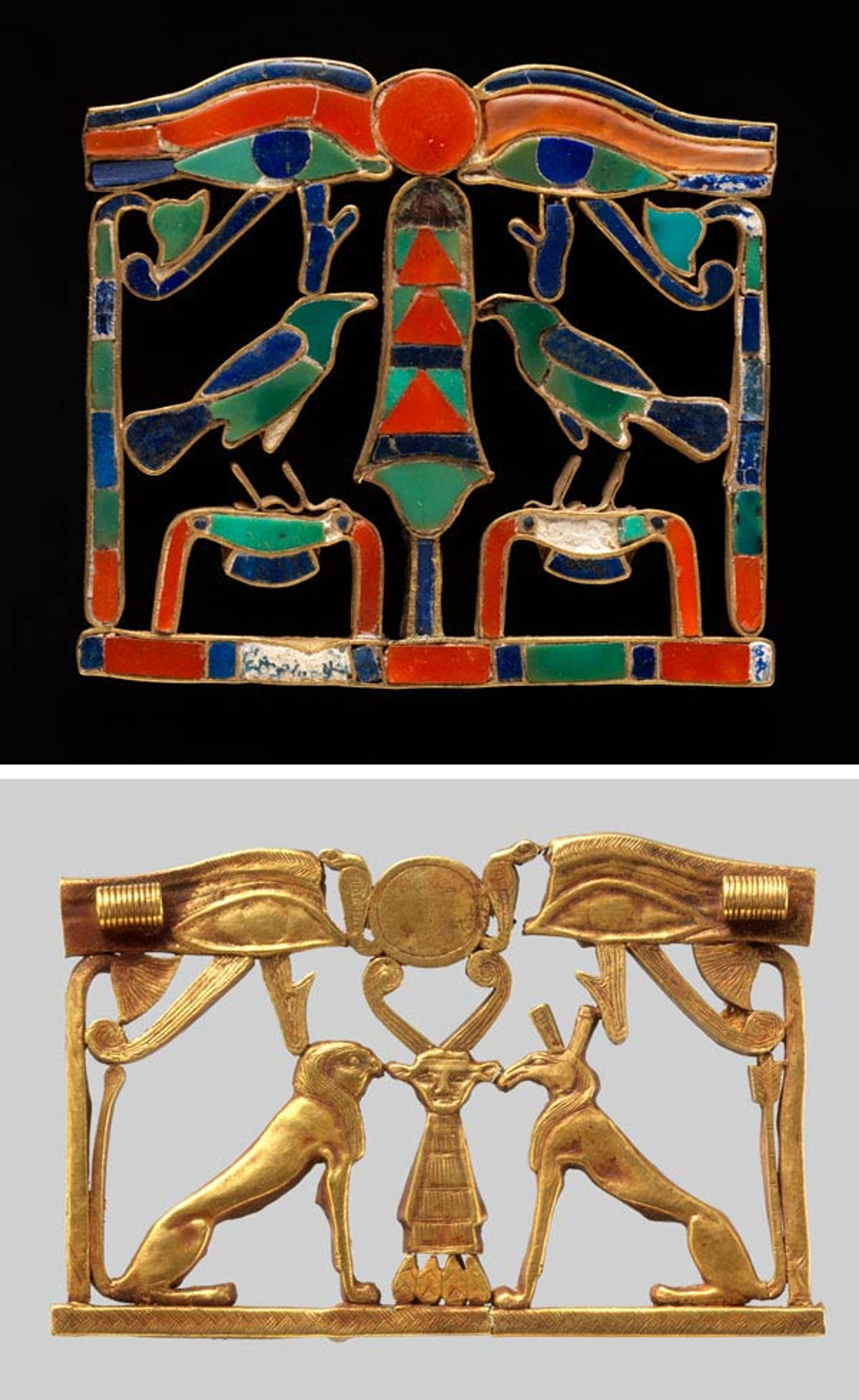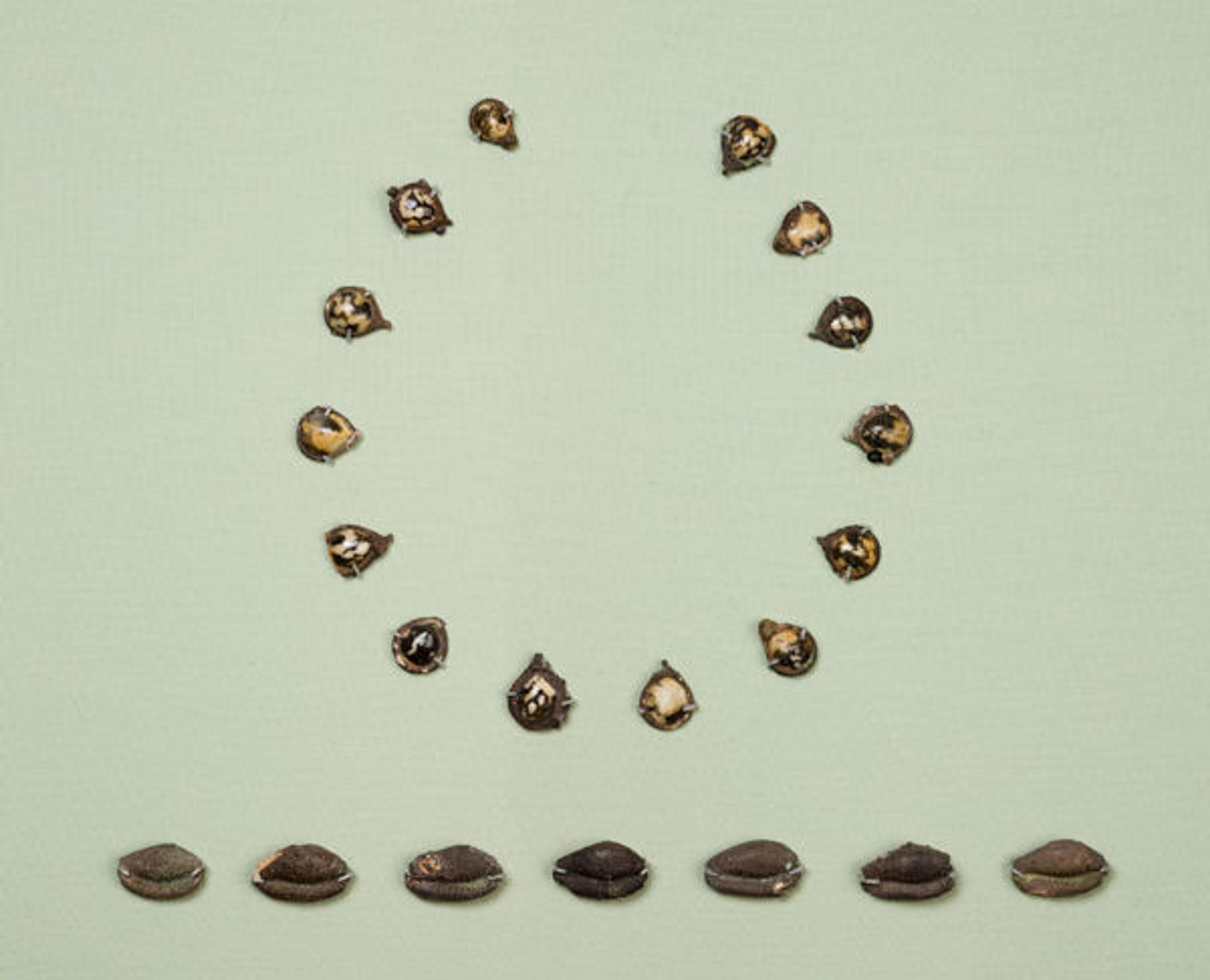Jewelry from the Haraga Treasure, United at the Met

Fig. 1. Elements from a pectoral. Middle Kingdom (ca. 1887–1750 B.C.). Haraga, Cemetery A, Tomb 124. Silver, lapis lazuli, carnelian, and faience. The Metropolitan Museum of Art, New York, Purchase, Lila Acheson Wallace Gift (2014.619.9–.15)
«The unexpected occurred just over a year ago, when the archaeological community learned of a surprising group of objects being offered for sale. Called the "Haraga Treasure," these pieces had belonged to the St. Louis Society, a local chapter of the Archaeological Institute of America, for about one hundred years. The objects found their way to St. Louis, Missouri, as a result of a generous act the Egyptian government practiced during the first seventy years of the twentieth century.»
Whenever archaeologists were granted permission to excavate in Egypt at that time, about half of the finds were ultimately given to the public institution that sponsored the archaeological work, while the other half, as well as any extraordinary or significant pieces, stayed in Egypt. The Met, which began excavating in Egypt in the winter of 1906–7 and continued to conduct regular seasons through 1936–37, received almost seventy percent of its collection of ancient Egyptian art through partage—that is, a division of artifacts.
The practice of partage sets the stage for the story of the Haraga Treasure. In 1913, an archaeologist working for The British School of Archaeology in Egypt, Reginald Engelbach, decided to explore small cemeteries south of Cairo near a village called Haraga. In all he excavated more than eight hundred tombs, most of which belonged to Dynasty 12 (ca. 1981–1802 B.C.) of the Middle Kingdom.
One large shaft tomb in particular, Tomb 124, attracted his attention. Although the tomb had been looted in antiquity, many pieces were still there. Sifting through the loose sand, Engelbach recovered beads, scarabs, and toilette equipment—including mirrors, razors, spoons, and several small stone vessels used to hold eye paint and ointments. One spoon of Egyptian alabaster (fig. 2) was exquisite, depicting half of a mollusk shell with a handle in the shape of an ankh, the hieroglyph the ancient Egyptians used for the words "life" and "living."

Fig. 2. Group of stone vessels from a tomb at Haraga. Middle Kingdom (ca. 1887–1750 B.C.). Haraga, Cemetery A, Tomb 124. The Metropolitan Museum of Art, New York, Purchase, Lila Acheson Wallace Gift (2014.619.1–.5)
When the Met realized that the collection of Haraga Treasure was at risk, and knowing this important set of archaeologically excavated objects should be kept together in a public institution where they would remain accessible, we proposed purchasing the entire group. The Met's offer was accepted and the objects came to New York, where they are now on display in gallery 111 (fig. 3).

Fig. 3. Diana Craig Patch and technicians install the objects from Haraga in gallery 111
Among Engelbach's most exciting finds were the pieces of rare jewelry, virtually all made from silver, the rarest of metals in ancient Egypt. Eight silver fragments were inlaid with tiny pieces of semiprecious stones: lapis lazuli from Afghanistan, turquoise from the Sinai mines, and carnelian from the Egyptian desert. Studies have shown that these pieces were part of a rare type of pectoral, a chest ornament suspended from a necklace. Only three Middle Kingdom pectorals have survived that formerly belonged to non-royal people, all of which are currently on view here at the Met: the pectoral from the Met's collection (fig. 1), in gallery 111; as well as the other two—from The Manchester Museum, The University of Manchester, and Johns Hopkins University Archaeological Museum for Eton College, Windsor, England—which are on loan to the Museum for the exhibition Ancient Egypt Transformed: The Middle Kingdom (fig. 4).

Fig. 4. Top: Pectoral with Birds Flanking an Ukh Symbol. Middle Kingdom, Dynasty 12 (ca. 1981–1802 B.C.). Riqqa, Cemetery A, Tomb 124. Carnelian, gold, lapis lazuli, etc. The Manchester Museum, The University of Manchester. Bottom: Pectoral with an Opposing Seth Animal and Hieracosphinx. Middle Kingdom, Dynasty 12 (ca. 1981–1802 B.C.). Probably from Dahshur. Gold. Lender Johns Hopkins University Archaeological Museum for Eton College, Windsor, England
Central to the original design of these pieces was the face of Hathor, the goddess of love and beauty and protector of the sun god. Unfortunately, only her horns and necklace survive. Although fragmentary, we now know that a pair of bees, papyrus stalks, and wedjat eyes protected this goddess in the pectoral's design.

Fig. 5. Fourteen pendants for a necklace (top) and seven beads in the shape of cowrie shells (bottom). Middle Kingdom (ca. 1887–1750 B.C.). Haraga, Cemetery A, Tomb 124. Silver and shell. The Metropolitan Museum of Art, New York, Purchase, Lila Acheson Wallace Gift (2014.619.16–.36)
The remaining elements of jewelry are just as important as the pectoral. The seven silver cowrie shell beads come from an ornament for a woman's hips (fig. 5, bottom), and several contain pellets that would have made a light tinkling noise as their owner danced. The drop pendants are unique and are thought to belong to a necklace (fig. 5, top). A three-dimensional element depicting a bee sipping nectar from a flower is unparalleled, but its style and shape suggests it may once have been part of a garland-like diadem.
The other two inlaid elements contain royal names and assign a date to the tomb. The isolated cartouche contains the name of King Senwosret II, who reigned from about 1887–1878 B.C., while the image of crowned falcon behind a scarab records the "Horus of Gold" name of Senwosret III, the king who ruled from about 1878 to 1840 B.C., so the original owner had most likely lived sometime between about 1887 and 1840 B.C.

Fig. 6. Stela of the Lady of the House Iytenhab. Middle Kingdom, Dynasty 12 (ca. 1981–1802 B.C.). Haraga, Cemetery A, Tomb 124. Limestone, paint; H. 48 cm (18 7/8 in.), W. 38 cm (14 15/16 in.), D. 14 cm (5 1/2 in.). Ny Carlsberg Glyptotek, Copenhagen (AEIN 1664)
This is actually a great time to come see the newly installed Haraga group, because a stela (fig. 6) excavated from the same tomb is here on loan from Copenhagen for Ancient Egypt Transformed. This monument is dedicated to a woman named Iytenhab, shown seated at the largest scale. Her baby boy is on the lap of another woman on the right, whose unusual epithet might indicate that she was a foster mother of the child after Iytenhab passed away prematurely. The jewelry now on display at the Met perhaps belonged to Lady Iytenhab.
The Haraga Treasure will become part of the permanent display, but the exhibition Ancient Egypt Transformed: The Middle Kingdom is open only through January 24, 2016.
Related Links
Ancient Egypt Transformed: The Middle Kingdom, on view October 12, 2015–January 24, 2016
Met Blogs: View all blog posts related to this exhibition.
Diana Patch
Diana Craig Patch, Lila Acheson Wallace Curator in Charge of the Department of Egyptian Art, is an Egyptologist specializing in archaeology, who received her PhD from the University of Pennsylvania. During her tenure at the Met, Patch has curated The Dawn of Egyptian Art (2012), an exhibition that demonstrated how Predynastic art contributed to the foundation of Pharaonic culture, and the exhibition Cleopatra's Needle (2013–14), which celebrated the Central Park icon. Additionally, she co-curated the reinstallation of the Predynastic and Early Dynastic gallery (2003). Patch has taught courses at the Institute of Fine Arts, City University of New York, and Rutgers University, and also lectures extensively. For the past thirty-five years, Patch has carried out fieldwork in Egypt and currently is co-director of the Joint Expedition to Malqata—a project for mapping, excavating, and restoring the festival city of Amenhotep III in western Thebes.
Kei Yamamoto
Kei Yamamoto, former Lila Acheson Wallace Research Associate and now Research Specialist at the University of Arizona, received degrees from the University of Pennsylvania (BA, 2001) and the University of Toronto (MA, 2002; PhD, 2009). As an Andrew W. Mellon Postdoctoral Curatorial Fellow at The Met, he participated regularly in the Museum's ongoing archaeological expedition to Dahshur. Kei has also excavated at Abydos and Tell Tebilla in Egypt. Before coming to the Met, he lived in Cairo and worked for the Grand Egyptian Museum Project.